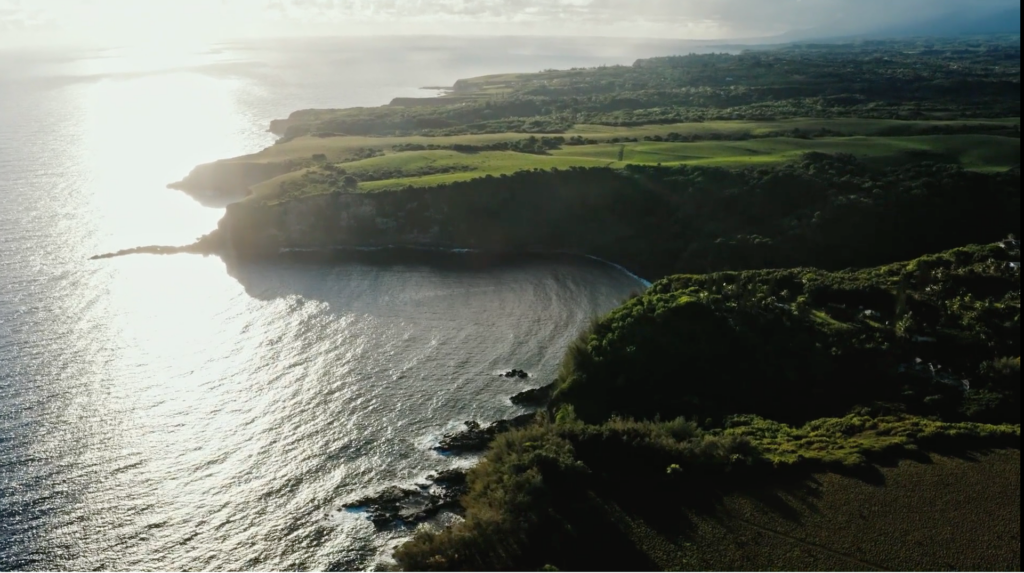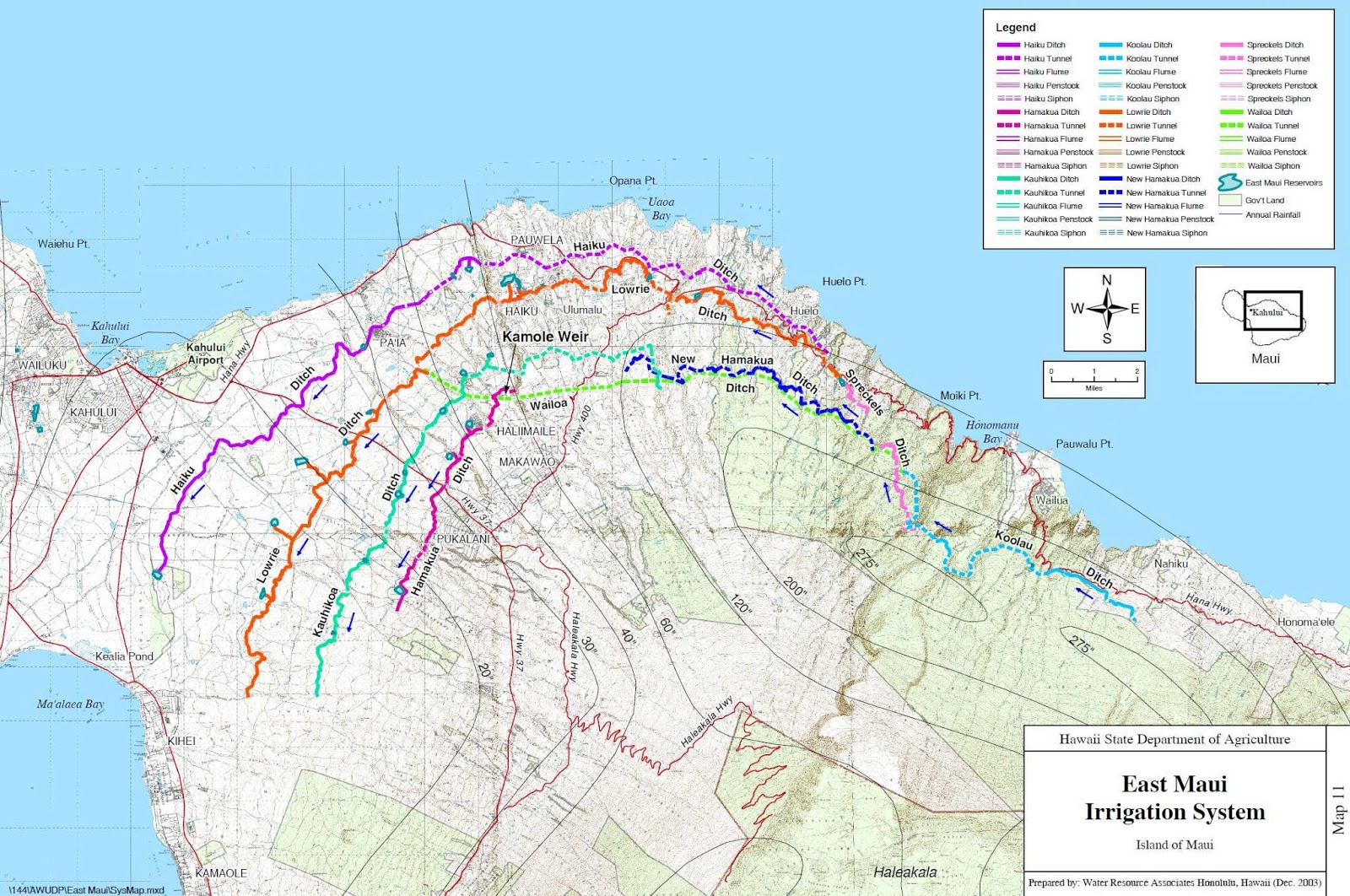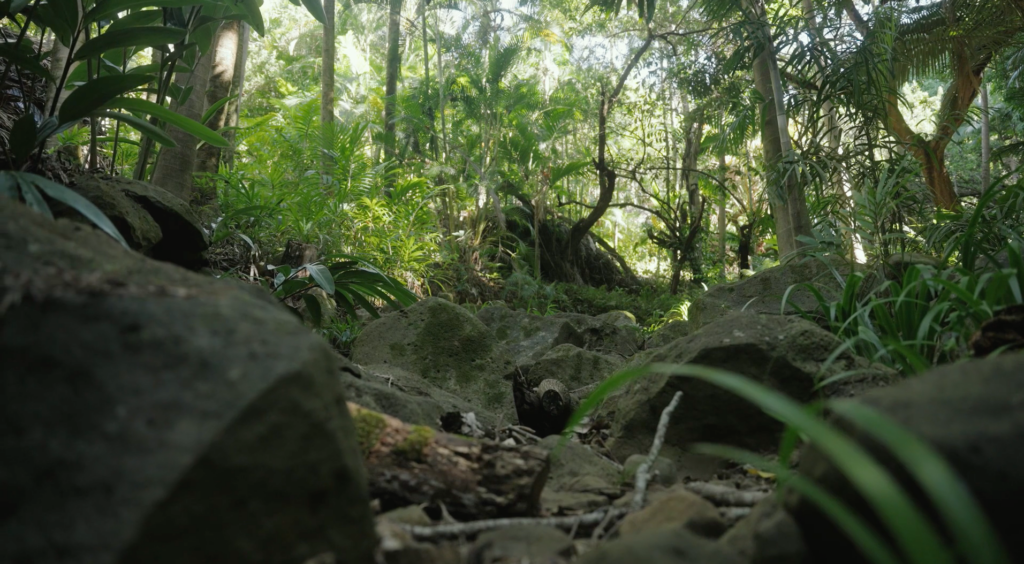
The Intention of Water: The Story of Pe‘ahi Stream
This post is from a series called Peʻahi Stories, a place- based literacy project launched in 2022.

Once I thought I could find
where it began
but that never happened
though I went looking for it
time and again
cutting my way past
empty pools and dry waterfalls
– W.S. Merwin, from his poem “One Valley”
In 1977, when W.S. Merwin first came to live on a parcel of land situated along the slopes of a dry Pe‘ahi Stream, he began an intimate relationship with this place that would last the rest of his life. I can imagine his curiosity as he got to know the landscape, and started to care for the first three acres of denuded land once destined for pineapple farming. I can picture him hiking up the stream bed to find its story, and its source. But like many streams in East Maui in the 1970s, fresh, flowing stream water had become a rarity here at Pe‘ahi. And like many streams in East Maui, the story of this Pe‘ahi Stream is a layered one. Through an ethnographic study conducted by Kepā and Onaona Maly, through conversations with neighbors as part of our “Pe‘ahi Stories” series, and through our own research, we are able to hear some of what Pe‘ahi Stream has to tell us.
When cultivating a sense of place in Hawai‘i, one quickly realizes the important role that fresh water resources have played from the beginning. The first people of this place believed that water was a resource to be shared by all, for common benefit. The documents referenced in the Malysʻ study show that communities living along Pe‘ahi Stream would have benefitted from abundant stream flows due to high levels of rainfall in the forest above.
According to the study:
The upper forest zone [above Pe‘ahi] receives some 400-inches of rain annually, and the lower elevations of Pe‘ahi, receive around 75-inches of rain annually, over a period of 161 days in any given year. The lower land, bisected by many gulches, were watered by streams, like that between Pe‘ahi and Halehaku, which formed in the rain and cloud forests above, and flowed to the sea.
Further, many primary source documents were cited to describe life in these valleys, including this oral history reference from Handy and Handyʻs Native Planters in Old Hawaii: Their Life, Lore, and Environment (1972):
For generations following initial settlement, communities were clustered along the wet, windward (ko‘olau) shores of the Hawaiian Islands. Along the ko‘olau slopes, streams flowed and rainfall was reliable, and agricultural production could be established—on lands that extend from the bays to the uplands. The ko‘olau region also offered sheltered bays from which both, near-shore deep sea fisheries could be easily accessed. The near shore fisheries were enriched by nutrients carried in the fresh water carried in streams flowing from the uplands. It was around these bays that clusters of houses where families lived could be found, and in these early times, the residents generally engaged in subsistence practices in the forms of agriculture and fishing. (page 287)
In East Maui where Pe‘ahi is located, kānaka maoli (Native Hawaiians) relied for generations on fresh stream water in their daily lives for many purposes, including to grow the sacred root vegetable known as kalo (taro), a staple food crop grown in lo‘i (wetland fields). Unlike many other plants, wetland kalo requires continuous stream water flowing through its fields. Abundant rains on Haleakalā and stream flows from mountain to ocean ensured that communities could grow food, and that these lo‘i kalo would feed many families. It also meant that there was abundant stream life and adequate water quality for the health of shoreline fisheries, a resource very important to the Hawaiian diet. The ‘auwai ( irrigation systems that feed the lo‘i), intricately hand-built stone by stone, were lifelines for scores of people on land and for the sea life just off shore. This is one reason why here in Hawai‘i, we often hear the phrase “ola i ka wai,” meaning “water is life.”
The Malys’ narrative elaborated on this relationship with the streams and landscape:
Over a period of several centuries, areas with the richest natural resources became populated and perhaps crowded, and by ca. 900 to 1100 AD, the population on each island began expanding to the more arid and remote area (see Cordy 2000:130). This was also the case on Maui. Based upon early historical observations (ca. A.D. 1778-1850), settlement in the watered valley and lower slope environments of Hāmākua Loa, consisted of permanent residences which centered near the shore and spread along the valley floors. Residences also extended inland along near- shore kula (flat lands or plateaus), and in fewer instances into the upper valleys. Temporary houses from which mountain resources (such as olonā, koa, and birds) were collected, extended into the upper valley areas, among fields on stream flats and on adjacent slopes. Two primary forms of agricultural sites occur in these watered valley contexts, they are the lo‘i kalo (irrigated and drainage taro farming field systems) on the valley floors and slopes; and the kula and kīhāpai dry land farming plots where crops such as ‘uala (sweet potatoes), kō (sugar canes), kalo (taro), mai‘a (bananas and plantains), and wauke (paper mulberry) were cultivated. (6)
Tending the stream water as part of a community of farmers meant there were limits. In fact, ancient irrigation systems came with laws for native farmers to follow: “No ‘auwai was permitted to take more water than continued to flow in the stream below the dam,” Emma Metcalf Naiuna, Hawai‘iʻs first female judge, wrote in “Ancient Hawaiian Water Rights and Some Customs Pertaining to Them,” in 1893. This measured use of the streams had existed for hundreds of years.
The story of people living along Pe‘ahi Stream begins much like this, with residences and stream-irrigated fields along its slopes and watered valleys, using just the amount of fresh stream water needed to feed the community, tending to the stream as it moved through their lo‘i, and then back out into the stream again, so it would eventually reach the sea.

The arrival of Westerners in 1778, and the influx of arrivals that followed, dramatically altered native life in Hawai‘i. More familiar with the concept of private property, these new island dwellers saw the water, native hardwoods, and other natural resources as assets to boost economic pursuits, including their large-scale plantations. This new way of thinking was foreign to kānaka maoli, and it caused conflict around how water and land could be used.
Eventually, with the development of massive sugarcane plantations in Hawai‘i, and the increase in these private businessʻ demand for fresh stream water, elaborate systems of water diversion were constructed, all with permission from the Kingdom of Hawai‘i. The abundant streams of East Maui were bisected by gravity-powered ditch systems upstream, and the public water needs of other users downstream–such as native kalo farmers–were disregarded.

In their research for the study, Kepā and Onaona Maly found a newspaper clipping, citing “natives of Pe‘ahi” and their concerns about the water:
August 1, 1904 (page 5)
Pacific Commercial Advertiser
Peahi-Huelo Water PetitionThe natives of the Peahi-Huelo region are making a petition to the President of the United States concerning the cutting off of their water supply by plantation ditches. They declare that streams that have run past their doorsteps as long as they can remember and have never been dry, had suddenly ceased to flow. They will not have recourse to the courts because those legal bodies make a decision one year and change it the next, and cite the Iao Valley water case to substantiate their position.
There is a rumor among Hawaiians that the water of the famous Polipoli Spring of Kula has suddenly disappeared. It has never been known to have dried up before.
This newspaper article was written nearly 120 years ago, and since then the people of Hawai‘i have experienced much change. Despite a decades-long fight to restore water rights to kalo farmers and the communityʻs successful efforts to proclaim water as a public trust in the State Constitution, private commodification of water continues to overpower the public interest. Even with these public trust laws in place, unraveling the practice of water diversion in East Maui is proving a lengthy process.
For more information about this history and the legal background of water rights, I suggest reading “Ola I Ka Wai: A Legal Primer for Water Use and Management in Hawai‘i,” by D. Kapua‘ala Sproat (2009).
The headwaters of Pe‘ahi Stream have been diverted to Central Maui since the early 1880s, leaving the streambed bone dry most of the year, disconnected from its source. Only when we experience a rare major rain event do we see the stream flowing with water, and even then, the stream bed is filled with runoff, not water from the uplands. Most of the time, we see a stream bed with those “empty pools and dry waterfalls” that William references in his poem.
In the mid-1980s, neighboring landowners decided to sell two parcels adjacent to the first three acres William had bought. They appreciated what he and Paula, who had joined William a few years before, were doing to restore the land and steward the streambed. They offered the land to them, and the Merwins bought it, increasing the footprint of their sanctuary for palms and people to just under 19 acres. It was at this point they could cross the stream bed and tend to the slopes on the other side, too.
Today, The Merwin Conservancy cares for this stream bed, and through our “Pe‘ahi Stories” outreach, conversations with neighbors have revealed that our interest in stewarding the stream is a shared one. After all, it is this stream that connects us to our watershed and to each other. Lately, conversations have explored the idea of neighborhood “work days” where we might coordinate regular clearing and monitoring of the stream valley. Together, we look forward to what the future may hold for Pe‘ahi Stream.

Recently, when standing along the stream bed with ethnobotanist and Merwin Conservancy board member Gary Paul Nabhan, I shared my reflections on the streamʻs history, and pointed to the large boulders in the stream bed as “evidence of water.” Gary, in his kind and thoughtful way, offered alternative language. He suggested that what is seen on the valley floor might instead be referred to as “the intention of water.”
With this new language, I was able to focus more intently on what isnʻt there now and reflect on the water that will be flowing there again. My mind returned again to Williamʻs poem “One Valley,” which now, to me, becomes a primary source document of its own, telling a part of the streamʻs history.
where the roaring torrent
raced at one time
to carve farther down
those high walls in the stone
for the silence that I hear now
day and night on its way to the sea
This program is made possible in part by funding from Hawaiʻi Council of the Humanities through the Sustaining the Humanities through the American Rescue Plan (SHARP) with funds from the National Endowment for the Humanities (NEH) and the federal American Rescue Plan (ARP) Act.
Any views, findings, conclusions, or recommendations expressed in this series, do not necessarily represent those of the National Endowment for the Humanities.